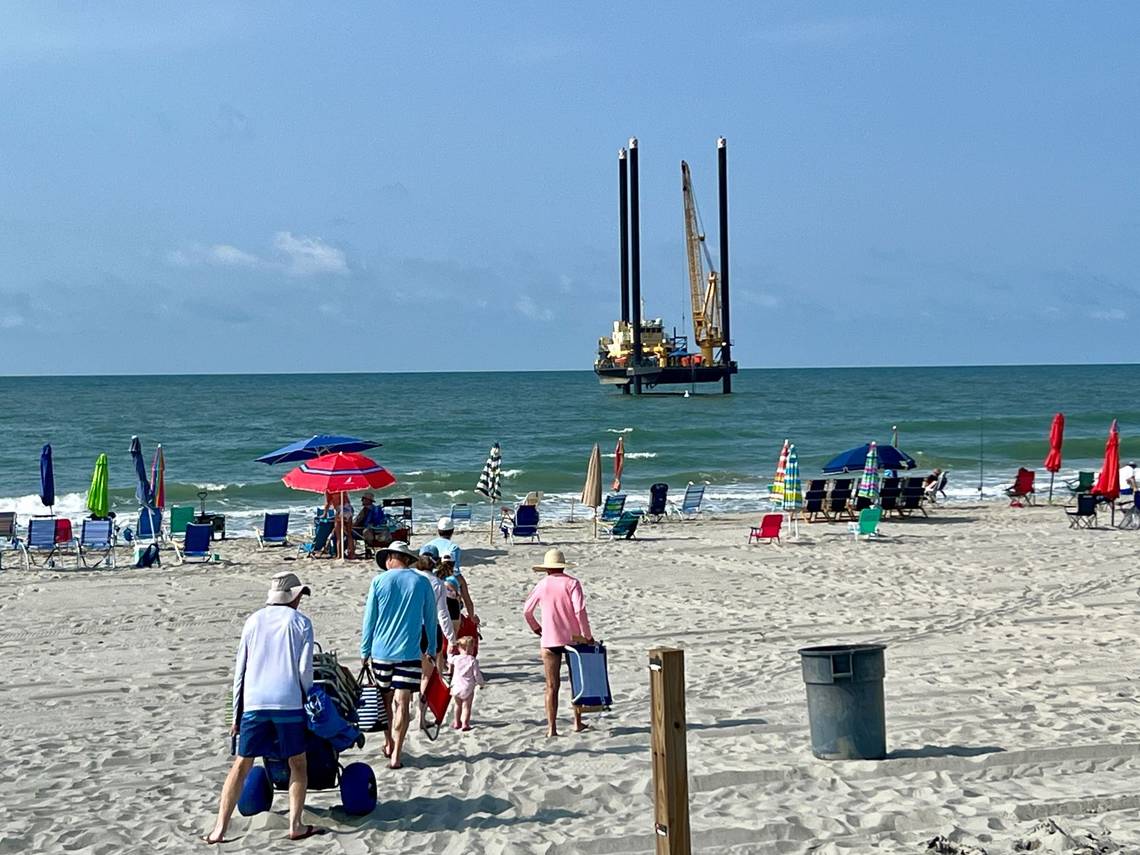
Have you seen those large metal looking structures sprinkled on the Grand Strand coastline this summer? The ones that look like they could be part of a deep sea oil drilling operation?
They’re actually part of routine storm drain maintenance and new ocean outfall construction.
The maintenance is happening in North Myrtle Beach, while construction of a brand-new ocean outfall is happening in Myrtle Beach.
“The City of North Myrtle Beach is in the process of inspecting and cleaning our ocean outfalls,” a statement from the city said. “While inspecting and cleaning, if deficiencies are found, they are repaired immediately by a diver.”
These inspections and cleanings happen approximately every five years, according to North Myrtle Beach’s Streets and Drainage Superintendent Johnny Bruton.
The project began over July Fourth weekend and is expected to wrap up this summer.
A few weeks ago, in mid-August, the City of Myrtle Beach began something that’s kind of similar, but not necessarily the same.
In order to replace 11 old storm water pipes that are on the beach, the city said in a statement that they began construction on a new ocean outfall at 24th Avenue North on Aug. 19.
“Ocean outfalls and stormwater pipes are important because they filter sediment, improve water quality and help catch trash before runoff water reaches the ocean,” the statement said. “Once built, the ocean outfall will replace 11 stormwater pipes currently on the beach.”
First crews began with building a trestle underwater, but will soon be starting beach construction on the project on Sept. 10, according to information from the city’s website.
“In 2018, the U.S. Environmental Protection Agency recognized the City of Myrtle Beach as part of the EPA’s program to celebrate innovation in clean water infrastructure. Since the late 1990s, the city has invested more than $75 million in stormwater management projects, including four existing deepwater ocean outfalls, at 25th Avenue South, Fourth Avenue North, 14th Avenue North and 53rd Avenue North,” Myrtle Beach’s Director of Public Information Meredith Denari said via email. “The term ‘stormwater’ describes rainfall that flows across impervious surfaces and into drainage structures. Ultimately, rainfall travels either to the Atlantic Ocean or the Atlantic Intracoastal Waterway.”
A previous release from the city said that construction would take place from 7 a.m. until 5:30 p.m. Monday through Saturday.
This will be the fifth time the city has constructed an ocean outfall, and they estimate the project will be completed by April 2025.
How much does it all cost?
In North Myrtle Beach, their project supervisor estimated earlier this summer that their work should cost somewhere between $600,000 to $700,000.
Documents from the South Carolina Department of Health and Environmental Control show that two years ago, the City of Myrtle Beach signed a grant agreement document with the state agency for $30 million for the Myrtle Beach Ocean Outfall Project.
The city’s director of public information, Meredith Denari, said those funds will be used to help pay for the project and that they were on this year’s South Carolina state budget.
In a letter sent to the state agency on Nov. 7, 2022, that was part of receiving the grant funds, Myrtle Beach Public Works Director Janet Curry wrote that the estimated cost of the new 24th Avenue North ocean outfall was $46 million.
Denari said via email on Friday morning that the accepted bid for the construction project was $42,639,830.
In 2016, Myrtle Beach completed their 4th Avenue North Ocean Outfall Project. A case study published by the South Carolina Rural Infrastructure Authority said the city received an $11.9 million loan for that project.
Is it safe to swim near an outfall?
Visit Myrtle Beach recommends not swimming within 200 feet in either direction of an ocean outfall, but said folks can still enjoy looking for shells and walking on the beach in those areas.
“The testing of our ocean water is very important and helpful in ensuring the cleanliness of our beaches. However, it can alarm people when there is a higher reading following heavy rainfall,” a statement on their website said. “It is true that stormwater runoff can occasionally boost test results and signs will be posted, but it is for limited sites for a limited time. Stormwater drains impact less than 2 percent of area beaches.”
Does this happen in other places?
The short answer to that question is yes.
Other municipalities in California and Florida have done similar projects on their shorelines with storm drains and ocean outfalls.
The Florida Department of Environmental Protection wrote a 29 page report about their ocean outfalls to Governor Ron DeSantis in 2020.
Across the country in California, the City of Ventura is wrapping up the completion of a brand new ocean outfall of their own, according to their latest construction update.
EMEA Tribune is not involved in this news article, it is taken from our partners and or from the News Agencies. Copyright and Credit go to the News Agencies, email news@emeatribune.com Follow our WhatsApp verified Channel





